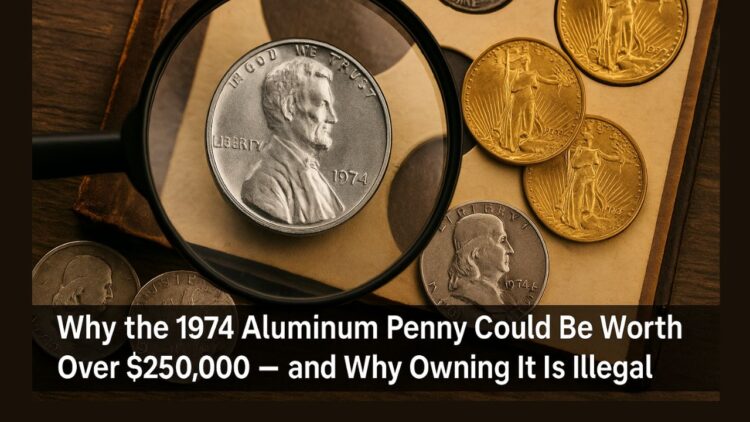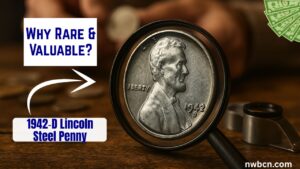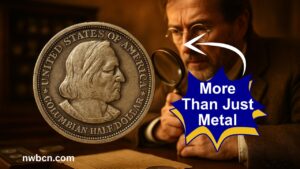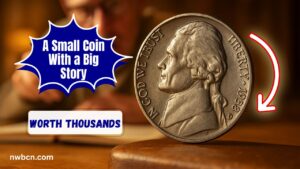The 1974 aluminum penny is one of the most captivating mysteries in modern U.S. numismatics. Created during a test-run due to soaring copper prices, these pennies were never officially released and were intended to be destroyed.
Today, the few that escaped recall could be worth between $250,000 and $2 million — yet owning one is technically illegal, as the U.S. Mint asserts they remain government property. This article dives into every detail: history, rarity, legal battles, valuation, and the ramifications for collectors.
Why Was the Aluminum Penny Proposed?
In late 1973, the cost of copper rose to a level where producing one cent in traditional bronze (95% copper, 5% zinc) nearly equaled its face value.
To avoid massive losses, the U.S. Mint tested alternate compositions, including one composed of 96% aluminum. Over 1.5 million aluminum cents dated 1974 were struck in Philadelphia between October 1973 and May 1974.
Distribution, Recall & Suppression
Mint officials handed out around 36 specimens to members of Congress and Treasury officials to gain approval. In the event of Congressional rejection, all coins were recalled and destroyed, except for a few intentionally retained or inadvertently missing.
Opposition energies, including from copper industry and vending machine manufacturers, cited concerns such as machine jams and difficulty detecting ingested aluminum via X‑ray.
How Many Survived?
Approximately 1,571,167 coins were struck in total. Only 12–14 specimens are believed to remain in private or institutional hands. Notable known survivors include:
- A specimen donated to the Smithsonian Institution
- A piece found by Capitol officer Albert P. Toven, later graded MS‑62
- A 1974‑D specimen from the Denver Mint, surfaced in 2014
The Unique 1974‑D Denver Example
Though no Denver minting was officially authorized, former employee Benito Martinez confirmed fewer than a dozen were struck on Denver “D” dies using aluminum blanks from Philadelphia.
This rare specimen, graded PCGS MS63, belonged to Harry Edmond Lawrence, Deputy Superintendent of Denver Mint, and was discovered by his son, Randall Lawrence, in 2014.
The U.S. Mint demanded its return, citing that aluminum cents were never legal tender and remained government property.
Valuation: $250,000 to $2 Million
Coin dealers initially estimated the 1974‑D aluminum penny value at $250,000–$2 million. The PCGS-graded MS63 coin was slated for auction in early 2014.
The Mint’s legal claim halted the auction; further valuation has not occurred due to its return. Experts consider the coin’s unprecedented rarity and legal complexity as drivers for its stratospheric value.
Why Is Owning It Illegal?
The Mint contends that since Congress never authorized aluminum pennies as legal tender, any surviving examples are still U.S. government property, regardless of how long in private hands.
In 2015, Judge William Q. Hayes allowed the case to proceed, acknowledging the possibility Lawrence had a legitimate claim. Ultimately, in March 2016, Lawrence returned the penny, and the government dropped the lawsuit.
This sets legal precedent: experimental coins not issued as legal tender remain government property, regardless of provenance.
Summary Table
| Detail | Information |
|---|---|
| Composition | 96% aluminum, trace metals; 19.05 mm diameter; 1.55 mm thickness; mass ≈ 0.937 g |
| Total struck | ≈ 1,571,167 in Philadelphia; fewer than a dozen in Denver |
| Surviving specimens | ~12–14 total; includes Smithsonian, Toven, Denver 1974‑D |
| Noteworthy specimens | Toven example (MS‑62); 1974‑D Lawrence example (MS‑63) |
| Legal status | Illegal to privately own; U.S. Mint regards them as government property |
| Valuation estimates | $250,000–$2 million, depending on condition, provenance, and rarity |
| Final disposition | Returned to Mint in March 2016; displayed at ANA World’s Fair later |
| Legal precedent | Experimental pattern coins not issued as legal tender remain U.S. government property |
Legal & Numismatic Implications
Using pattern coins such as the 1974 aluminum cent as evidence, the government argues that ownership of non-issued coins is void, even if privately held.
Conversely, collectors maintain that many unissued pattern coins dating back over a century are freely owned and traded without interference, making this enforcement unprecedented.
The case is now legal precedent, discouraging collectors from pursuing similar experimental specimens without clear legal title. Additionally, it amplifies the importance for collectors to confirm legal status and paper trail for any experimental coin.
The Auction That Never Was
An auction by Heritage Auctions was planned for April 2014. Just before bidding opened, the U.S. Mint intervened with a lawsuit. In July 2015, Judge Hayes rejected dismissal, allowing the claim to proceed.
The penny was returned in March 2016, resulting in auction cancellation. The government later loaned or placed the penny on display at the 2016 ANA World’s Fair.
Collector Advice
Authentication & Grading
PCGS, NGC, and ANACS offer grading—e.g., the Denver piece graded MS63 by PCGS.
Legal Clearance
Verify if the Mint or Treasury holds title; avoid legal entanglements.
Provenance Is Key
The Denver coin’s connection to a Mint official was central to the legal dispute.
Rarity & Condition
Only a dozen examples exist, some of which are institutional; any surviving piece is extraordinary.
Insurance & Security
Should a rare aluminum cent be legitimately owned in the future, ensure high-grade insurance and secure storage.
The 1974 aluminum penny is more than just a rare coin—it’s a powerful illustration of the intersection between mint experimentation, legal precedent, and collector fascination. Struck in response to copper cost crises, nearly all were destroyed.
The few that survived became subjects of legal battle, with the Denver “D” specimen being the most prominent example, valued between $250,000 and $2 million.
Nevertheless, this value came at the cost of ownership: the U.S. Mint still claims them as federal property, regardless of origin. Their seizure and subsequent charter display at major coin shows confirm their status.
For collectors, this story is a stark reminder: rarity doesn’t override legality. While pattern coins may yield sensational values, only those with absolute legal status are safe to collect.
Frequently Asked Questions
1. Can I legally own a 1974 aluminum penny?
No. The U.S. Mint maintains that they remain federal property because they were never authorized as legal tender. Any existing examples are considered government-owned.
2. How many 1974 aluminum pennies still exist?
Numismatic research estimates around 12–14 survivors, including the Smithsonian’s, the Officer Toven specimen, and the rare Denver “D” example.
3. Could they ever sell for over $2 million?
Potentially. Deemed unique or extremely rare, market estimates have set values between $250,000 to $2 million depending on condition and uniqueness.




